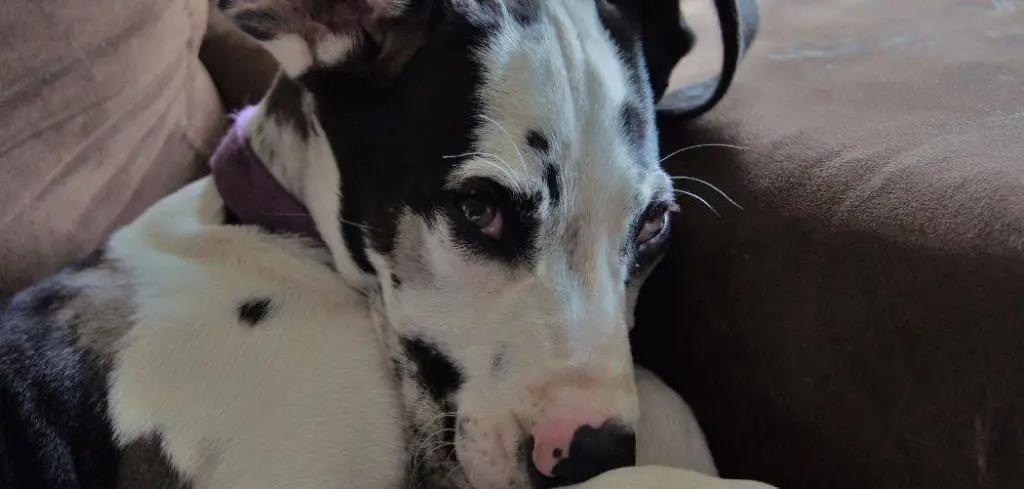If a dog is constantly licking its paws, it may seem like a harmless habit, but it often signals an underlying problem.
Persistent paw licking can be uncomfortable for the dog and frustrating for the owner, especially if it leads to redness, sores, or infections.
We outline the common reasons a dog may constantly lick its paws, what you can do at home, and when to seek veterinary help.
Table of Contents
Dog Constantly Licking Paws — Why It Happens
Dogs may constantly lick their paws due to irritation, pain, or underlying health conditions that cause discomfort. Common triggers include allergies, skin infections, injuries, parasites, or even anxiety-related behaviors. In some cases, paw licking is a way for dogs to soothe themselves, but it often points to a problem that requires attention.

Dog Constantly Licking Paws: Common Causes
Allergies
Allergies are one of the most frequent reasons dogs lick their paws. Food allergies, environmental triggers like pollen, or reactions to cleaning products can cause itching and inflammation.
Dogs will lick their paws to relieve the discomfort, but this often makes the skin raw and more prone to infection.
Signs may include red, inflamed paw pads, constant chewing, or licking after walks. Allergies can be long-term issues and may require dietary changes, medications, or ongoing management under veterinary guidance.
Read more: Dog Constantly Licking Bottom (When you should be concerned)
Skin Infections (Bacterial or Yeast)
Bacterial or yeast infections can develop between a dog’s toes or paw pads. These infections are itchy and irritating, leading dogs to lick excessively to try and soothe themselves.
Owners may notice a strong odor, redness, or discharge from the affected paw. Left untreated, infections can worsen and spread, making them painful and more difficult to manage.
Paw licking in these cases is usually a sign the infection is already causing significant discomfort.
Injuries or Foreign Objects
A cut, thorn, insect sting, or even a small pebble stuck between the toes can cause sudden and persistent licking.
Dogs instinctively lick wounds as a way to clean them, but excessive licking can delay healing or introduce new bacteria.
If licking starts suddenly after outdoor activity, an injury or foreign body is a likely cause. Owners should carefully inspect the paw pads, nails, and spaces between toes for signs of trauma.
Parasites
Fleas, mites, and ticks can bite or burrow into a dog’s skin, causing intense itching. The paws are often a target, especially with parasites like mites that cause mange.
Licking may be accompanied by scratching, hair loss, or scabs around the paws. Parasite infestations require prompt veterinary treatment, as they can spread quickly and cause serious skin irritation.
Anxiety or Compulsive Behavior
Sometimes, dogs lick their paws not because of a physical problem but due to stress or anxiety. Licking can be a self-soothing behavior, similar to nail-biting in humans. Over time, it can become a compulsive habit.
Stress-related paw licking often occurs when a dog is left alone, bored, or experiencing environmental changes.
While it may not start as a medical problem, it can lead to skin infections if it continues unchecked.
Arthritis or Joint Pain
Older dogs, or those with joint problems, may lick their paws as a response to pain. Arthritis, hip dysplasia, or other orthopedic issues can cause discomfort in the legs and paws, prompting repetitive licking.
Owners may notice stiffness, limping, or reluctance to exercise along with the paw licking.
Pain-driven licking is often a sign that a dog is struggling with mobility and may benefit from pain management strategies.
What to Do If Your Dog Is Constantly Licking Its Paws
Start by inspecting your dog’s paws closely for cuts, swelling, foreign objects, or visible parasites. Cleaning the area gently with a pet-safe antiseptic solution can help prevent infection in minor injuries.
If allergies are suspected, wiping your dog’s paws after walks can reduce contact with pollen or chemicals. Switching to a limited-ingredient diet or hypoallergenic food may also reduce allergic reactions over time.
For mild irritation, using an Elizabethan collar (cone) can prevent over-licking and give the paw time to heal. Keeping nails trimmed and paw fur neat can also reduce irritation.
Engaging your dog with more exercise, toys, or interactive play may help if the licking is stress-related. Providing mental stimulation often reduces boredom-driven behaviors.
However, persistent paw licking usually requires professional evaluation. Home care can help with mild irritation, but veterinary diagnosis is important to address underlying causes.
When to Call or Visit Your Vet
If your dog’s paw licking continues for more than a few days, a vet visit is recommended. Redness, swelling, bleeding, or discharge are clear signs of infection or injury that need medical attention.
Seek immediate help if your dog is limping, whining when the paw is touched, or if multiple paws are affected at once. These could signal serious conditions such as arthritis, autoimmune issues, or widespread skin infections.
Dogs with hair loss, scabs, or a foul odor from the paws should also be examined promptly. These are signs that the skin barrier has been broken and infection is progressing.
Persistent licking combined with changes in appetite, energy, or behavior should never be ignored. These broader symptoms can indicate systemic illness and require prompt veterinary care.
Read more: Dog Constantly Licking (What it really means)
Key Takeaway
A dog constantly licking its paws is usually a sign of discomfort, not just a quirky habit. Allergies, infections, injuries, parasites, and even stress can all contribute to this behavior.
While some mild cases can be managed at home with cleaning and monitoring, persistent licking almost always deserves veterinary attention. Getting to the root cause not only relieves your dog’s discomfort but also prevents more serious complications.
By paying attention to your dog’s behavior and acting quickly, you can help restore comfort and ensure your pet stays healthy and happy.
